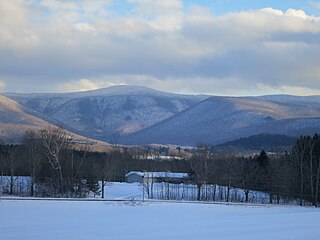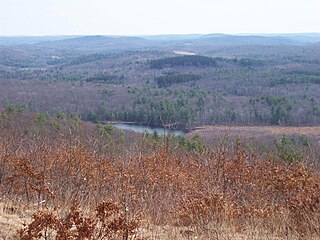Related Research Articles

Pownal is a town in Bennington County, Vermont, United States. As of the 2020 census, the town population was 3,258. The town of Pownal includes the villages of Pownal, North Pownal, and Pownal Center.

Williamstown is a town in Berkshire County, Massachusetts, United States. It shares a border with Vermont to the north and New York to the west. Located in Berkshire County, the town is part of the Pittsfield, Massachusetts metropolitan statistical area. The population was 7,513 at the 2020 census. A college town, it is home to Williams College, the Clark Art Institute and the Tony-awarded Williamstown Theatre Festival.

Mount Greylock is the highest point in Massachusetts at 3,489 feet. Located in the northwest region of the state, it is part of the Taconic Mountains, a geologically distinct range from the nearby Berkshires and Green Mountains. Expansive views and a small area of sub-alpine forest characterize its upper reaches. A seasonal automobile road crosses the summit area near three structures from the 1930s; these together constitute a small National Historic District. Various hiking paths including the Appalachian Trail traverse the area, which is part of the larger Mount Greylock State Reservation.

Adams is a town in northern Berkshire County, Massachusetts, United States. It is part of the Pittsfield, Massachusetts Metropolitan Statistical Area. The population was 8,166 at the 2020 census.

The Watchung Mountains are a group of three long low ridges of volcanic origin, between 400 and 500 feet high, lying parallel to each other in northern New Jersey in the United States. The name is derived from the American Native Lenape name for them, Wach Unks. In the 18th century, the Euro-American settlers also called them the Blue Mountains or Blue Hills. The Watchung Mountains are known for their numerous scenic vistas overlooking the skylines of New York City and Newark, New Jersey, as well as their isolated ecosystems containing rare plants, endangered wildlife, rich minerals, and globally imperiled trap rock glade communities. The ridges traditionally contained the westward spread of urbanization, forming a significant geologic barrier beyond the piedmont west of the Hudson River; the town of Newark, for example, once included lands from the Hudson to the base of the mountains. Later treaties moved the boundary to the top of the mountain, to include the springs.

The Taconic Mountains are a 150-mile-long sub-range of the Appalachian Mountains lying on the eastern border of New York State and adjacent New England. The range, which played a role in the history of geological science, is separated from the Berkshires and Green Mountains to the east by a series of valleys, principally those of the Housatonic River, Battenkill River and Otter Creek. The Taconics' highest point is Mount Equinox in Vermont at 3,840 feet (1,170 m); among many other summits are Dorset Mountain, Mount Greylock and Mount Everett.

"Thanatopsis" is an early poem by the American poet William Cullen Bryant. Meaning 'a consideration of death', the word is derived from the Greek 'thanatos' (death) and 'opsis'.
Rome Sand Plains is a 15,000-acre (61 km2) pine barrens about five miles (8.0 km) west of the city center of Rome in Oneida County in central New York. It consists of a mosaic of sand dunes rising about 50 feet (15 m) above low peat bogs that lie between the dunes. The barrens are covered with mixed northern hardwood forests, meadows, and wetlands. About 4,000 acres (16 km2) are protected in conservation preserves. Pine barrens are typical of seacoasts; the Rome Sand Plains is one of only a handful of inland pine barrens remaining in the United States. A second inland pine barrens, the Albany Pine Bush, is also found in New York, located north and west of state's capital Albany.
Jonathan Robinson was an American politician, lawyer, and judge from the state of Vermont who served as chief justice of the Vermont Supreme Court and a United States senator.

Weir Hill Reservation is a 194-acre (0.79 km2) public park located in the town of North Andover, Massachusetts. The Trustees of Reservations owns and maintains the property.

Mohawk State Forest, also known as Mohawk State Forest/Mohawk Mountain State Park, encompasses over 4,000 acres (1,600 ha) in the towns of Cornwall, Goshen, and Litchfield in the southern Berkshires of Litchfield County, Connecticut. As overseen by the Connecticut Department of Energy and Environmental Protection, the area is used for hiking, picnicking, and winter sports by the public, while being actively managed to produce timber and other forest products.

Cowles Bog is a 4,000-year-old wetland complex in Indiana Dunes National Park, near Chesterton, Indiana. It is named for Henry Chandler Cowles who did his pioneering work in ecology and ecological succession here. His work brought international attention to the area which led to efforts to preserve the Indiana Dunes. It was designated a National Natural Landmark in 1965. It contains bog, fen, marsh, wet meadow, swamp, and pond habitats.

Volo Bog State Natural Area is a nature reserve in Illinois, United States, preserving Volo Bog. The bog was designated a National Natural Landmark in 1973 as the only remaining open-water quaking bog in Illinois. The site also contains woodlands, savanna, marshes, prairie restoration areas, shrubland and old fields. Maintained by the Illinois Department of Natural Resources, the site is located about a mile west of U.S. Route 12 between the towns of Volo and Fox Lake, Illinois.

Watchung Reservation is the largest nature reserve in Union County, New Jersey, United States. The Watchung area is located on a ridge within northern-central New Jersey, as it consists mainly of the upper valley of Blue Brook, between the ridges of the First Watchung Mountain and Second Watchung Mountains. A dam near the headwaters of the creek creates Lake Surprise.

Bartholomew's Cobble is a 329-acre (1.33 km2) National Natural Landmark, open space preserve, agricultural preserve, and bio-reserve located in southwest Massachusetts in the village of Ashley Falls abutting Canaan, Connecticut. The preserve contains more than 800 plant species, including North America's greatest diversity of ferns and the greatest overall biodiversity in Berkshire County, Massachusetts; it also contains Massachusetts' highest populations of ground nesting bobolinks. It was declared a National Natural Landmark in October 1971.

Natural Bridge State Park is a Massachusetts state park located in the city of North Adams in the northwestern part of the state. Named for its natural bridge of white marble, unique in North America, the park also offers woodland walks with views of a dam made of white marble, and a picturesque old marble quarry.

Teatown Lake Reservation is a nonprofit nature preserve and environmental education center in Westchester County, New York, U.S., located in the towns of Ossining, Yorktown, Cortlandt, and New Castle. The reservation includes an 1,000-acre (4.0 km2) nature preserve and education center, visited annually by around 25,000 people.

Gray Lock, , was a Western Abenaki warrior chieftain of Woronoco/Pocumtuck ancestry who came to lead the Missisquoi Abenaki band, and whose direct descendants have led the Missisquoi Abenaki until the current day. Born near what is now Westfield, Massachusetts, he eventually became the most illustrious and prominent leader to arise among the dwindling Waranoak, once the predominant original inhabitants of the central Connecticut River Valley in today's New England region.

Benjamin Simonds was an American militia officer who served in King George's War, the French and Indian War and the American Revolutionary War. He was colonel of the all-Berkshire regiment of about five hundred men known as the "Berkshire Boys" during the Revolutionary War. His regiment, the 2nd Berkshire County Regiment, fought in the Battle of Bennington in the summer of 1777.

The Anthony Kill, also called Tenandeho Creek, is a stream ("kill") in Saratoga County, New York approximately 8 miles (13 km) long. Its source is the east end of Round Lake, and it flows east into the Hudson River in Mechanicville. It drains an area of approximately 53 square miles (140 km2).
References
- ↑ Grace Greylock Niles at Find a Grave
- 1 2 3 4 5 Stevens, Lauren R. (May 16, 2016). "A good writer and a great eccentric". The Berkshire Eagle.
- ↑ "Grace Greylock Niles Trail". Hiking Project.
- ↑ "Review of Bog-trotting for Orchids". The Saturday Review of Politics, Literature, Science and Art. 99: 316. 11 March 1905.
- ↑ "Review of Bog-trotting for Orchids". The Plant World: An Illustrated Monthly Journal of Popular Botany. 7 (6): 161–162. June 1904.
- ↑ "Review of The Hoosac Valley. Its Legends and Its History". The Athenaeum (4442): 727. 14 December 1912.
- ↑ International Plant Names Index. G.G.Niles.